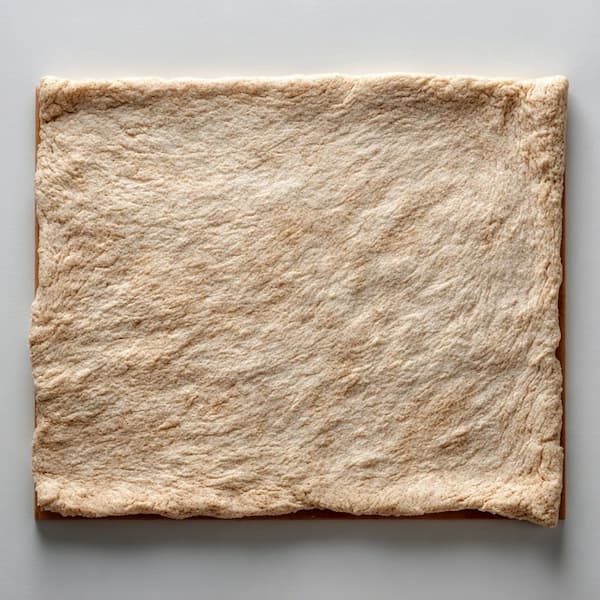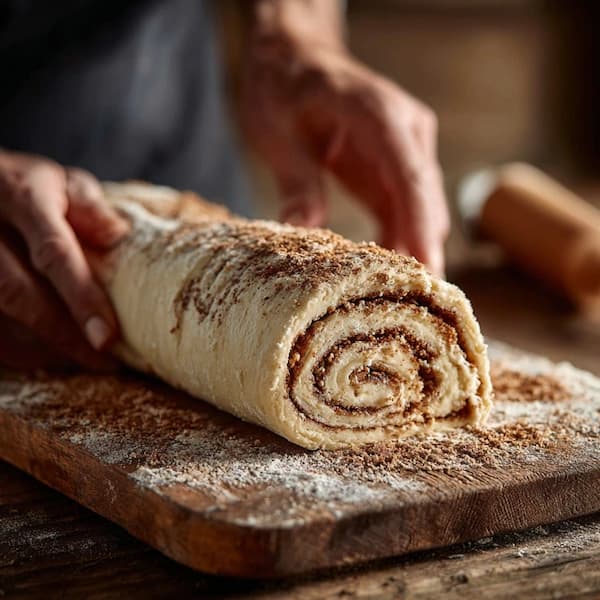If you love homemade cinnamon rolls but want to give them a little upgrade, sourdough cinnamon rolls are the way to go. They’re soft, buttery, and filled with sweet cinnamon goodness.
When I first started baking with sourdough, I thought of bread and pizza dough, not cinnamon rolls. But the first time I tried this recipe, I was hooked.
These rolls take time — but it’s the good kind of time. The slow rise builds flavor, and your kitchen fills with that unmistakable scent of butter, sugar, and warm bread.

Why Use Sourdough?
Sourdough adds a gentle tang and a pillowy texture you can’t get with instant yeast. It also gives you flexibility — the long fermentation lets you work the dough on your own schedule. Plus, it’s a great way to use up some of your sourdough starter while making something sweet instead of just bread.
Even if you’re new to sourdough baking, this recipe is forgiving. Once you mix the dough, most of the magic happens while you rest, shape, and bake.
Ingredients You’ll Need
For the Dough
- 1 cup active sourdough starter (fed and bubbly)
- ¾ cup whole milk, lukewarm
- ¼ cup unsalted butter, melted
- ¼ cup granulated sugar
- 1 large egg
- 3 cups all-purpose flour (plus extra for kneading)
- ½ teaspoon salt
For the Filling
- ⅓ cup unsalted butter, softened
- ½ cup brown sugar, packed
- 1 ½ tablespoons ground cinnamon
For the Glaze
- 1 cup powdered sugar
- 2 tablespoons cream or milk
- ½ teaspoon vanilla extract
Mix the Dough
In a large bowl, whisk together the sourdough starter, milk, melted butter, sugar, and egg. Stir until smooth. Add the flour and salt, then mix until a soft dough forms.
Knead the dough for 5–7 minutes on a lightly floured surface, or until it becomes smooth and elastic. It should feel slightly tacky but not sticky. Place it back in the bowl, cover it, and let it rest for 30 minutes.
Let It Rise Slowly
After the short rest, give the dough one or two stretch-and-folds (pulling the dough from the edge and folding it over itself). Cover the bowl with plastic wrap or a damp towel and let it rise at room temperature for 4–6 hours, or until it’s doubled in size.
If you want to make it ahead, place the dough in the fridge overnight. The cold fermentation enhances flavor and makes the dough easier to handle in the morning.
Roll It Out
Once the dough has risen, turn it out onto a floured surface and roll it into a rectangle about 12×16 inches. Spread the softened butter evenly over the dough, then sprinkle on the brown sugar and cinnamon mixture.

This step always reminds me of childhood baking days — the smell of cinnamon filling the air, and the anticipation of that first warm roll out of the oven.
Shape the Rolls
Starting from the long edge, roll the dough tightly into a log. Slice it into 9 or 12 even pieces (a piece of unflavored dental floss works great for clean cuts).

Place the rolls in a greased 9×13-inch baking dish, leaving a bit of space between them to rise. Cover and let them proof for 2–3 hours at room temperature, or until puffy and nearly doubled.
Bake to Golden Perfection
Preheat your oven to 375°F. Bake the rolls for 20–25 minutes, or until golden brown and the centers are cooked through.
The smell that fills your kitchen while these bake is pure comfort — buttery, sweet, and cozy. It’s hard not to peek inside the oven, but trust me, it’s worth the wait.
Add the Glaze
While the rolls are baking, whisk together powdered sugar, cream, and vanilla to make the glaze. Adjust the consistency by adding more milk for a thinner drizzle or more sugar for a thicker icing.
Once the rolls are out of the oven, let them cool for 10 minutes before glazing. Spread or drizzle the icing over the warm rolls so it melts slightly into the swirls.

Tips for Success
- Active starter: Make sure your sourdough starter is bubbly and active before using.
- Plan ahead: Sourdough takes longer to rise, so start early or refrigerate overnight.
- Soft butter only: For the filling, use butter that’s soft enough to spread but not melted.
- Proofing: The rolls should look puffy before baking — don’t rush this step.
- Storage: Keep leftovers covered at room temperature for up to two days or in the fridge for up to five.
Why I Love This Recipe
For me, these sourdough cinnamon rolls are more than just a weekend bake — they’re a ritual. Mixing the dough, waiting for the rise, shaping the rolls — it’s a slow process that somehow feels grounding.
The result is a pan of soft, golden rolls that taste both homemade and special. They’re perfect for cozy mornings, lazy brunches, or as a treat to share with friends and family. Every bite is a reminder that good things really do take time.
Storing and Reheating
To keep your rolls fresh, store them in an airtight container at room temperature for up to two days or in the fridge for up to five. You can also freeze them (baked or unbaked).
If frozen unbaked, let them thaw and rise before baking as usual. For baked rolls, reheat in the oven at 325°F for 10 minutes or microwave individual rolls for 15–20 seconds.
Can I Make Sourdough Cinnamon Rolls Overnight?
Absolutely — in fact, the overnight method often makes them even better. After shaping the rolls and placing them in the baking dish, cover tightly with plastic wrap and refrigerate overnight. The slow, cold fermentation deepens the flavor and makes the dough easier to handle in the morning.
When you’re ready to bake, take the rolls out of the fridge and let them sit at room temperature for about 1–2 hours, until they look puffy and slightly risen. Then bake as directed. This method is perfect if you want fresh, warm cinnamon rolls for breakfast without waking up at dawn.
Can I Use Sourdough Discard Instead of Active Starter?
You can — but with one small adjustment. Sourdough discard doesn’t have the same rising power as active starter, so you’ll need to add a bit of yeast (about 1 teaspoon of instant yeast) to help the dough rise properly. The discard still gives the rolls that tangy flavor, but the yeast ensures you get the soft, fluffy texture you want.
If you’re using discard and yeast together, you can shorten the rise time slightly — about 2–3 hours for the first proof instead of 4–6. It’s a great way to use up extra starter while still getting that delicious sourdough depth of flavor.

Ingredients
Method
- In a large bowl, whisk together the sourdough starter, milk, melted butter, sugar, and egg. Stir until smooth.
- Add the flour and salt, then mix until a soft dough forms.
- Knead the dough for 5–7 minutes on a lightly floured surface, or until it becomes smooth and elastic
- Place it back in the bowl, cover it, and let it rest for 30 minutes.
- After the short rest, give the dough one or two stretch-and-folds (pulling the dough from the edge and folding it over itself).
- Cover the bowl with plastic wrap or a damp towel and let it rise at room temperature for 4–6 hours, or until it’s doubled in size.
- Once the dough has risen, turn it out onto a floured surface and roll it into a rectangle about 12×16 inches.
- Spread the softened butter evenly over the dough, then sprinkle on the brown sugar and cinnamon mixture.
- Starting from the long edge, roll the dough tightly into a log. Slice it into 9 or 12 even pieces
- Place the rolls in a greased 9×13-inch baking dish, leaving a bit of space between them to rise.
- Cover and let them proof for 2–3 hours at room temperature, or until puffy and nearly doubled.
- Bake the rolls for 20–25 minutes, or until golden brown and the centers are cooked through.
- Whisk together powdered sugar, cream, and vanilla to make the glaze.
- Once the rolls are out of the oven, let them cool for 10 minutes before glazing. Spread or drizzle the icing over the warm rolls so it melts slightly into the swirls.
Notes
- Active starter: Make sure your sourdough starter is bubbly and active before using.
- Plan ahead: Sourdough takes longer to rise, so start early or refrigerate overnight.
- Soft butter only: For the filling, use butter that’s soft enough to spread but not melted.
- Proofing: The rolls should look puffy before baking — don’t rush this step.
- Storage: Keep leftovers covered at room temperature for up to two days or in the fridge for up to five.



